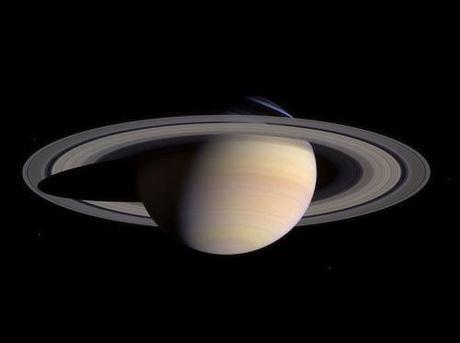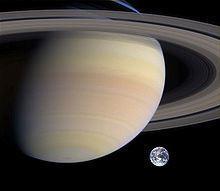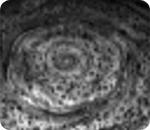
Saturn is the sixth planet from the Sun and the second largest planet in the Solar System, after Jupiter. With an average radius about nine times that of Earth, Saturn is over 95 times more massive than Earth. Below right is a composite image of Saturn and Earth, showing the difference in sizes. ↓

The Cassini–Huygens is a robotic spacecraft mission – a cooperative project of NASA, the European Space Agency,and the Italian Space Agency to study the planet Saturn. Launched on October 15, 1997, Cassini-Huygens finally entered into orbit around Saturn on July 1, 2004, after a long interplanetary voyage.
On December 25, 2004, the Huygens probe was separated from the orbiter and reached Saturn’s moon Titan on January 14, 2005, when it descended into Titan’s atmosphere, and downward to the surface, radioing scientific information back to the Earth. This was the first landing ever accomplished in the outer solar system.
Even before Cassini entered into orbit around Saturn, as the spacecraft passed over the rings of Saturn, 234 million miles from the planet, Cassini began detecting these eerie radio signals. Pay particular attention at around the 1:30 mark.
NASA says the radio waves are closely related to the auroras near the poles of Saturn. These auroras are similar to Earth’s northern and southern lights.
NASA’s explanation is compatible with the classic Christian notion of the harmony of the spheres. Go here to view and listen to a fascinating presentation on the Harmony.

The entire structure rotates with a period of 10h 39m 24s — the same period as that of the planet’s radio emissions.
The origin of the hexagonal cloud pattern is a matter of much speculation. Most astronomers believe it was caused by some standing-wave pattern in the atmosphere (whatever that means!). Polygonal shapes have been replicated in the laboratory through differential rotation of fluids.
“This is a very strange feature, lying in a precise geometric fashion with six nearly equally straight sides,” said Kevin Baines, atmospheric expert and member of Cassini’s visual and infrared mapping spectrometer team at NASA’s Jet Propulsion Laboratory, Pasadena, Calif. “We’ve never seen anything like this on any other planet. Indeed, Saturn’s thick atmosphere where circularly-shaped waves and convective cells dominate is perhaps the last place you’d expect to see such a six-sided geometric figure, yet there it is.”
The hexagonal cloud is strange enough. But Mike Adams of Natural News thinks he sees, in the center of the rotating hexagon, a pyramid shape with an eye in the middle. (Cue “Twilight Zone” music!)
H/t FOTM’s CSM.
~Eowyn

